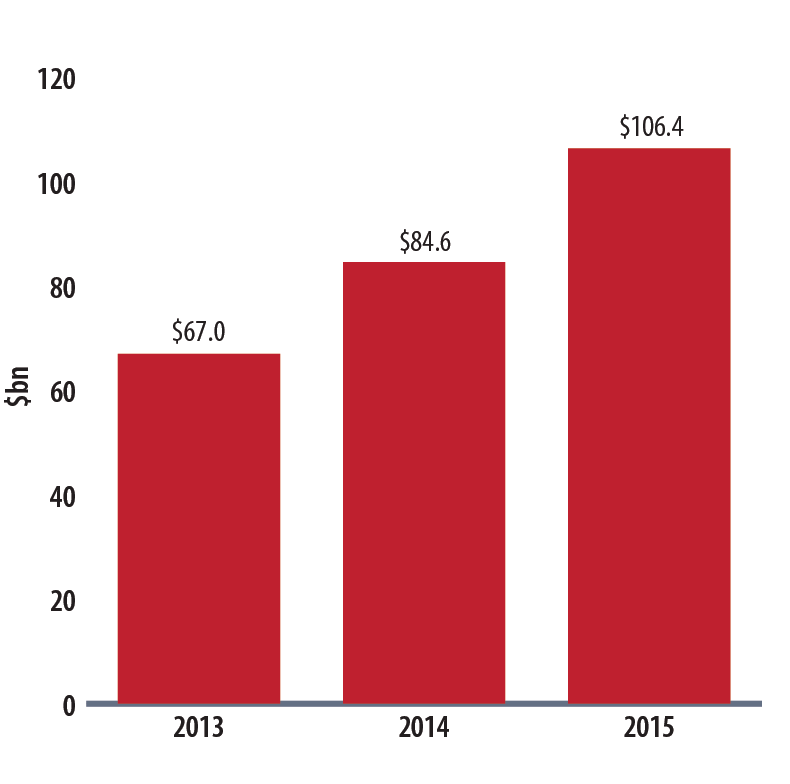Pharma's Middlemen Get Fatter: PBM, Health Plan Rebates Near $58bn
Executive Summary
Negotiated health plan and PBM rebates and fees have nearly doubled since 2013, PhRMA-commissioned report finds. After other rebates and discounts are added in, manufacturers retained 63% of total gross spending on branded drugs (based on list prices) –a decline, albeit less dramatic, from 2013.
More than one-third of the list price of a brand drug goes to other stakeholders in the supply chain – pharmacy benefit managers, health plans, government agencies and others – in the form of rebates and other fees, according to a report by the Berkeley Research Group.
All in all, the factors that erode the proportion of list price realized by drug makers includes statutory rebates, fees and discounts in government programs such as Medicaid and Medicare Part D, prices negotiated with private-sector payers, patient cost-sharing assistance, and the impact of supply chain entities, such as pharmacy/provider margin and wholesaler margin. The report notes that these increased in the aggregate each year between 2013 and 2015 (see chart), with some, such as PBM and health plan fees, increasing particularly dramatically.
And while the total net amount in dollars received by manufactures have increased over the years of the study, the amount as a percentage of gross expenditures has declined.
Commissioned by the Pharmaceutical Research and Manufacturers of America and issued Jan. 18, the report supports a message industry has been trying to get across to policymakers and the public: that a significant portion of the gains from high drug prices and price increases is consumed by parties other than manufacturers. Industry negotiates rebates with payers to secure a good position on formularies, but the practice leaves physicians and patients in the dark about the actual cost of a medicine. While the message has been reiterated frequently, there have been little in the way of detailed numbers previously available to underpin it.
Manufacturers net only 39% of initial gross drug expenditures, defined as the sum of payments for prescription drugs made by patients and their health plans at the point of sale prior to any rebate, discount or fee provided by the drug maker, according to the report, "The Pharmaceutical Supply Chain: Gross Drug Expenditures Realized By Stakeholders.“ Of the remainder, 42% goes to non-manufacturer entities, the report says, with 22% going to participants in the supply chain, such as PBMs, and 20% comprising retrospective rebates, discounts and fees.
|
Gross Brand Drug Expenditures By Component (In Billions) |
|||||
|
Type of Component |
Component |
2013 |
2014 |
2015 |
|
|
Initial Gross Drug Expenditures1 |
$244.9 |
$306.3 |
$349.1 |
||
|
Statutory Rebates and Fees |
Medicaid Drug Rebate Program2 |
$19.1 |
$23.0 |
$28.3 |
|
|
Part D Coverage Gap Discounts |
$4.2 |
$5.1 |
$5.8 |
||
|
TRICARE Rebates & Federal Supply Schedule Discounts |
$3.5 |
$4.6 |
$4.7 |
||
|
Excise Fee3 |
$2.8 |
$3.0 |
$3.0 |
||
|
Market Access Rebates and Discounts |
Negotiated Health Plan and PBM Rebates and Fees4 |
$33.2 |
$43.5 |
$57.7 |
|
|
Patient Cost Sharing Assistance |
$4.2 |
$5.4 |
$6.9 |
||
|
Supply Chain Entities |
Pharmacy/Provider Margin5 |
$17.5 |
$18.5 |
$20.4 |
|
|
Wholesaler Margin6 |
$2.3 |
$2.7 |
$3.1 |
||
|
GPO Administrative Fees |
$0.6 |
$0.6 |
$0.7 |
||
|
Net Amount Realized by Brand Manufacturer ($) |
$177.5 |
$199.9 |
$218.6 |
||
|
Net Amount Realized by Brand Manufacturer (%) |
67.0% |
65.3% |
62.6% |
||
|
[1] Components may not sum to total due to rounding. [2] Component includes statutory rebates, supplemental rebates negotiated by states and managed care plans, and 340B margin. [3] Component represents annual fee paid by brand manufacturers as stipulated in the Affordable Care Act (ACA). [4] Component includes the portion of gross drug expenditures that may be retained by health plans and PBMs through their role in the pharmaceutical payment process. This may not be inclusive of all health plan or PBM revenue streams (e.g., claims administration fees, utilization management service fees, etc.). [5] Component represents the difference between what a pharmacy or non-retail provider is paid for the drugs it dispenses and the price at which those drugs were acquired. Includes rebates paid by manufacturers to long-term care pharmacies. [6] Component represents the difference between what a drug wholesaler is paid by pharmacies for drugs and what the wholesaler paid to acquire those drugs from the manufacturer, inclusive of prompt-pay discounts and stocking fees. |
|||||
|
Source: BRG’s The Pharmaceutical Supply Chain: Gross Drug Expenditures Realized By Stakeholders |
|||||
The new research suggests retrospective rebates and discounts, which reduce the final net spending for payers and the overall health care system, are not adequately understood in the debate around drug pricing. "Pharmaceutical spending estimates that omit rebates and discounts do not fully reflect the underlying competitive dynamics of the pharmaceutical sector and provide a misleading impression of drug spending," it states.
Underscoring the political and public image issues in play, PhRMA President and CEO Stephen Ubl, in a release announcing the report, asked, “Are we doing enough to ensure the growing amount of rebates and discounts flow to the patient?” BRG notes that the rebates used to secure formulary placement "benefit patients indirectly through lower premium payments, the discounts themselves do not directly reduce the amount patients must pay to meet a deductible and do not always reduce their required co-insurance and co-payments at the point-of-sale."
Pricing issues took center stage at the recent J.P. Morgan Healthcare Conference, which coincided with new comments from President-elect Donald Trump about pushing drug companies to negotiate with the government on drug prices. (Also see "Pharma’s Pricing Debate Splinters As US Political Confrontation Looms" - Scrip, 18 Jan, 2017.)
Retrospective Rebates, Discounts And Fees For Brand Medicines

Source: BRG report
Although the report brings some definitive numbers to the debate, the issue is not new. In April 2016, a Bain & Co. report revealed that rebates as a percentage of US prescription drug sales had increased by 14 percentage points over the seven-year period from 2007-2014. Rebates accounted for 19% of gross US pharma sales in 2007, the report found, but increased to 33% in 2014. (Also see "Industry's Rebate Arms Race: Securing Market Access At A Cost" - Scrip, 20 Apr, 2016.)
Further, a report issued by IMS Health that same month demonstrated that discounts and rebates largely offset price increases to brand name drugs. The research estimated that such concessions offset price increases by 77%-81% in 2015 and that while list prices rose 12.4% that year, net prices increased only 2.8% on average. (Also see "Price Concessions By Manufacturers To Payers Rose Sharply In 2015" - Pink Sheet, 14 Apr, 2016.)
In a note overviewing last April's IMS report, Bernstein analyst Tim Anderson suggested that if the trends outlined within continued "net US drug pricing might accordingly slip into negative [year-over-year] territory, mirroring the gradual price erosion that occurs in almost all other developed countries outside of the US."
